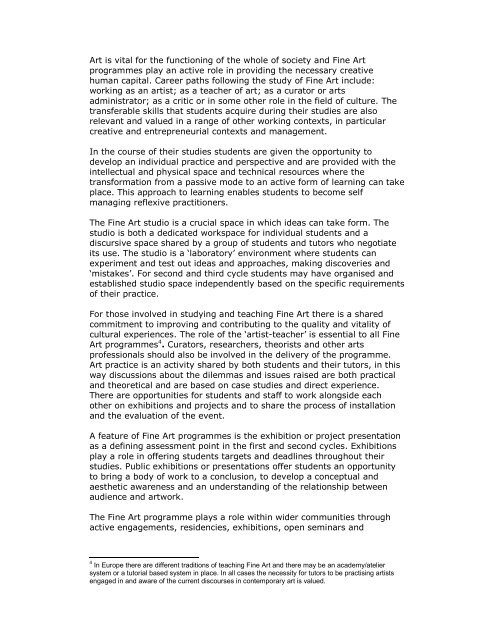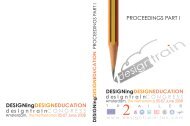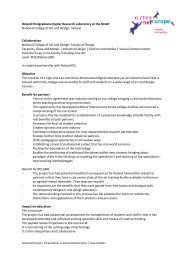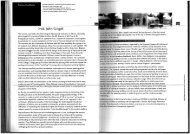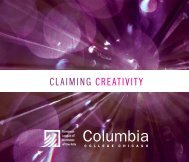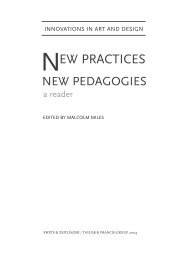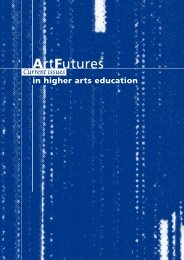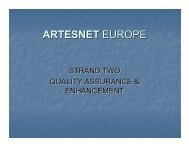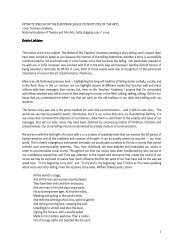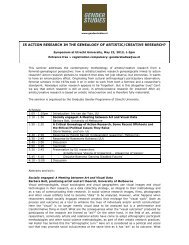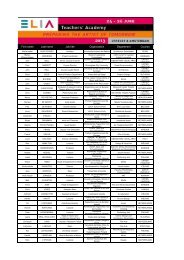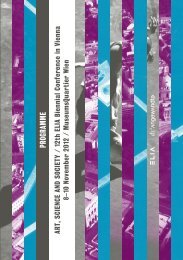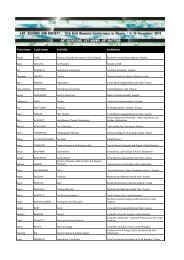CONTENTS FINE ART TUNING DOCUMENT - ELIA
CONTENTS FINE ART TUNING DOCUMENT - ELIA
CONTENTS FINE ART TUNING DOCUMENT - ELIA
You also want an ePaper? Increase the reach of your titles
YUMPU automatically turns print PDFs into web optimized ePapers that Google loves.
Art is vital for the functioning of the whole of society and Fine Art<br />
programmes play an active role in providing the necessary creative<br />
human capital. Career paths following the study of Fine Art include:<br />
working as an artist; as a teacher of art; as a curator or arts<br />
administrator; as a critic or in some other role in the field of culture. The<br />
transferable skills that students acquire during their studies are also<br />
relevant and valued in a range of other working contexts, in particular<br />
creative and entrepreneurial contexts and management.<br />
In the course of their studies students are given the opportunity to<br />
develop an individual practice and perspective and are provided with the<br />
intellectual and physical space and technical resources where the<br />
transformation from a passive mode to an active form of learning can take<br />
place. This approach to learning enables students to become self<br />
managing reflexive practitioners.<br />
The Fine Art studio is a crucial space in which ideas can take form. The<br />
studio is both a dedicated workspace for individual students and a<br />
discursive space shared by a group of students and tutors who negotiate<br />
its use. The studio is a ‘laboratory’ environment where students can<br />
experiment and test out ideas and approaches, making discoveries and<br />
‘mistakes’. For second and third cycle students may have organised and<br />
established studio space independently based on the specific requirements<br />
of their practice.<br />
For those involved in studying and teaching Fine Art there is a shared<br />
commitment to improving and contributing to the quality and vitality of<br />
cultural experiences. The role of the ‘artist-teacher’ is essential to all Fine<br />
Art programmes 4 . Curators, researchers, theorists and other arts<br />
professionals should also be involved in the delivery of the programme.<br />
Art practice is an activity shared by both students and their tutors, in this<br />
way discussions about the dilemmas and issues raised are both practical<br />
and theoretical and are based on case studies and direct experience.<br />
There are opportunities for students and staff to work alongside each<br />
other on exhibitions and projects and to share the process of installation<br />
and the evaluation of the event.<br />
A feature of Fine Art programmes is the exhibition or project presentation<br />
as a defining assessment point in the first and second cycles. Exhibitions<br />
play a role in offering students targets and deadlines throughout their<br />
studies. Public exhibitions or presentations offer students an opportunity<br />
to bring a body of work to a conclusion, to develop a conceptual and<br />
aesthetic awareness and an understanding of the relationship between<br />
audience and artwork.<br />
The Fine Art programme plays a role within wider communities through<br />
active engagements, residencies, exhibitions, open seminars and<br />
4 In Europe there are different traditions of teaching Fine Art and there may be an academy/atelier<br />
system or a tutorial based system in place. In all cases the necessity for tutors to be practising artists<br />
engaged in and aware of the current discourses in contemporary art is valued.


